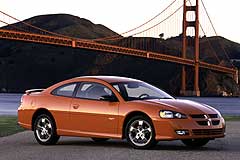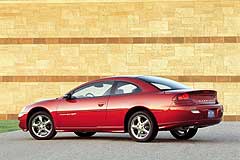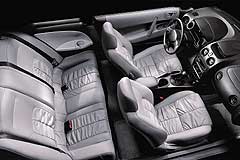
Car Review of the 2003 Dodge Stratus Coupe
Base MSRP Range:
Base Invoice Range:
Price Quote MSRP As Tested: Not Avialable Versions: SXT, R/T Vehicle Category: Mid-Size Coupe Engine Location: Front Engine Drive Wheels: Rear-Wheel Drive Rear-Wheel DriveFront-Wheel Drive
Four-Wheel Drive
All Wheel Drive Engine As Tested: 2.4-liter,
Single Overhead Cam, , 16-valves,
Inline 4 cylinder,
Manual 147, Automatic 142 horsepower at 5,500 rpm and Manaul 158 lb-ft, Automatic 155 lb-ft torque at 4000 rpm Optional Engine: 2.4-liter,
Single Overhead Cam, , 24-valves,
V-6 cylinder,
Manual 200, Automatic 198horsepower at 5,500 rpm and 205 lb-ft torque at 4500 rpm Transmission As Tested: 5-Speed Manual or optional 4-Speed Automatic Fuel Economy (city/hwy): 5-speed manual ohc I4
24/32 , ohc V6 21/29, 4-speed automatic ohc I4
21/28, ohc V6 20/28
Standard Safety Features: Driver and front passenger, front and side airbags, front ventilated disc brakes, rear drum brakes, Traction Control, In-Trunk Emergency Trunk Release, Daytime Running Lights, Brake Assist, Electronic Brake Force Distribution, Rear Obstacle Detection System, engine immobilizer, . Competition: Honda Accord, Nissan Altima, Toyota Camry, Ford Tarus, Mercury Sable, Mitsubishi Glalant, Mazda 6
BLUE RIDGE, Ga. -- After only two years on the market, slinky Stratus the coupe in Dodge's line from DaimlerChrysler whips up muscular new front and rear styling with racy lines and two trim treatments revised for editions of 2003.
The strong but stubby face of Stratus in two-door coupe format focuses on a revamped prow with fresh fascia, a smoothly curving cross-hair grille and narrow corner headlamp clusters, plus new foglamps in a unique angular shape that coordinates with center slot-like fascia vents.
Interrupting the smooth lines, flat panels on each side of the car hint at the shapes of NASCAR racers as muscular shoulders toward the rear suggest strength.
Shapely curving rear pillars at the back of the roofline slide down into rolled rear flanks that form the shoulders on the rump. Then in back the tail design bends a spoiler lip in arching line over large corner lamps and a thick bumper tinted to the body color.
The graceful arched profile and exaggerated slant to the windshield reflect styling concepts borrowed from Dodge's Intrepid flagship sedan, although the new prow design with prominent cross-hair grille obviously comes directly off the racy Dodge sports car, Viper.
Dodge introduced Stratus as a mid-size two-door coupe in 2001 to replace the Avenger series with a stiff new platform and more powerful engine options.
Yet the name became a point of confusion because the Stratus label also applies to a four-door Dodge sedan that looks similar to the coupe, although sedan and coupe versions of Stratus do not share platforms, engines, mechanical hardware or components.
Actually, the nearest cousin to Stratus the coupe may be found in the Chrysler line with the Sebring coupe, as both cars flow from a joint-venture assembly plant in Illinois that also produces the Mitsubishi Eclipse coupe, which uses the same chassis, suspension and powertrains.
Two different engine options define the personality of Stratus the coupe, which splits with engine selections into the trims of SXT and R/T.
The SXT badge is new for 2003 to define the price-leading entry model.
The R/T edition marks the sporty model, with the initials abbreviating a designation of "Road and Track" in recognition of Dodge's muscle car heritage.
For Stratus SXT, a 2.4-liter in-line-four engine carries an overhead cam, four valves per cylinder and sequential multi-point fuel injection.
This base engine when mated with the standard five-speed manual transmission produces 147 hp at 5500 rpm plus torque of 158 lb-ft at 4000 rpm.
Add the optional four-speed automatic and it makes 142 hp at 5500 rpm with 155 lb-ft of torque at 4000 rpm.
More power comes from Stratus R/T, which stocks a dual-cam 3.0-liter V6 dispensing 200 hp at 5500 rpm and 205 lb-ft of torque at 4500 rpm.
The manual stick works with the V6 in Stratus R/T and it feels good with short throws on the shift lever and fluid movements up and down the gear ladder.
The four-speed automatic is also available with the V6. It uses an intelligent controller through a microprocessor that quickly adapts to the driver's style and then changes the shift patterns to suit that style.
On Stratus R/T, the automatic shifter also includes a clutch-less shift mode called AutoStick.
Simply pull the shift lever back into the manual setting and you can make gear-by-gear shifts without having to pump a clutch.
We log seat time in Stratus over the Appalachian Mountains of Georgia while sampling versions like Stratus R/T with the AutoStick four-speed automatic and base SXT with a five-speed manual.
What these drives demonstrate is the confident road manners plus an exacting quality in the way all of the mechanical hardware meshes together. We really like the stiff yet smooth ride characteristics and see that Sebring can be downright agile when steered through a set of curves, such as the snaky course on Georgia 5 from McCaysville to Blue Ridge through the Chattahoochee National Forest.
The chassis design for Stratus is strong, due to stiff rails and cross braces that enhance the platform's rigidity to resist bending and torsional twisting. This rigid structure becomes the foundation for attaching suspension components that feel tight and precise.
Suspension elements include front MacPherson struts with lower A-arms, braces for shock towers and an anti-roll bar added. In the rear, the multi-link arrangement employs upper A-arms that unite with the lower lateral and semi-trailing links, plus anti-roll bar.
The steering system -- with speed-sensitive power governing the rack and pinion mechanism -- reacts quickly and provides excellent feedback.
Brakes build in complexity, starting with ventilated discs up front and rear drums with tandem booster power assistance on Stratus SXT but solid discs in back on the R/T.
Computerized anti-lock brakes (ABS) with a traction control system (TCS) are optional for R/T.
Passive safety measures include three-point seatbelts for all five seat positions and dual-stage frontal air bags, with curtain-style air bags that tuck into the headliner above side windows also available.
The structural scheme for Stratus carves out generous space for riders by extending the windshield forward to the firewall and increasing the length and width of the cabin while abbreviating space up front for the engine.
Sculptured dashboard indentions flanking the central pod of climate and audio controls define individual cockpits for driver and passenger.
Instruments, clustered below an arched cowl, display round analog gauges. The bright white faces on gauges are ringed by bezel trimmed in faux carbon-fiber.
Two high-back bucket seats draped in cloth fabric or optional leather flank a center console in front of a bench for three that has folding seatbacks split 60/40 for access to the trunk.
Unlike some sports coupes, Stratus has a chassis that's long enough to leave room in the backseat for adult riders.
Another rare trait for a smooth coupe concerns the bottom line, as Dodge casts Stratus with affordable price points that begin at $20,090 for the SXT with a manual shifter or $22,585 for Stratus R/T with the manual.
Pros: XXXXXXXXXX Cons: XXXXXXXXX Ratings (1-10)

Editors' Ratings
More Data
Where Built: XXX
Major Options: Larger wheels and tires, upgraded audio system, leather upholstery, side-curtain airbag, power driver's seat, remote keyless entry, power sunfoor, 4-wheel Antilock Disc Brakes,
Seating: 5
Number of Rows: 2
Crash Test Ratings:
- NHTSA Frontal Impact/Driver Crash Test Rating: Not Yet Tested
- NHTSA Frontal Impact/Passenger Crash Test Rating: Not Yet Tested
- NHTSA Side Impact/Front Seat Crash Test Rating: Not Yet Tested
- NHTSA Side Impact/Rear Seat Crash Test Rating: Not Yet Tested
- NHTSA Rollover Resistance Rating: Not Yet Tested
- IIHS Frontal Offset Crash Test: Not Yet Tested
Length in Inches: 190.9
Warranties: 3 years/36,000 miles bumper-to-bumper, 5 years/100,000 miles corrosion, 7 years/70,000 mile powertrain, 3 years/36,000 miles free Roadside Assistance.
Weight in Pounds: Manual - 3,064. Automatic – 3,133.
Cargo Capacity in Pounds: Not Available
Gross Maximum Vehicle Weight in Pounds: Not Available
Towing Capacity in Pounds: 1,000
Gas Tank Capacity in Gallons: 16.3
Destination Charge: $625




